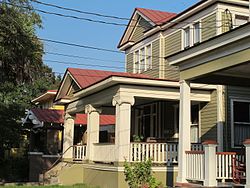Hampton Park Terrace
|
Hampton Park Terrace Historic District
|
|

Houses along Huger St. produce a consistent streetscape.
|
|
| Location | Roughly bounded by Hagood, and Rutledge Aves., and Moultrie, and Congress Sts., Charleston, South Carolina |
|---|---|
| Coordinates | 32°47′47″N 79°57′17″W / 32.79639°N 79.95472°WCoordinates: 32°47′47″N 79°57′17″W / 32.79639°N 79.95472°W |
| Area | 31 acres (13 ha) |
| Built | 1912 |
| Architectural style | Late 19th And Early 20th Century American Movements, Late 19th And 20th Century Revivals |
| NRHP Reference # | 97001186 |
| Added to NRHP | September 26, 1997 |
Hampton Park Terrace is the name both of a neighborhood and a National Register district located in peninsular Charleston, South Carolina. The neighborhood is bounded on the west by The Citadel, on the north by Hampton Park, on the east by Rutledge Ave., and on the south by Congress St. In addition, the one block of Parkwood Ave. south of Congress St. is considered, by some, to be included. The National Register district, on the other hand, is composed of the same area with two exceptions: (1) the northeasternmost block is excluded and (2) an extra block of President St. is included.
The land upon which the neighborhood is built was rural land until approximately 1900. At about that time, a few streets began being laid out in the northern end of the city. A few small houses were constructed at that time, but most of the land remained undeveloped. In 1912, three large sections of the neighborhood were platted. Those sections roughly correspond to the northwest quadrant, the southwest quadrant, and the southeast quadrant. They were developed by, respectively, the Charleston Building & Investment Co., Hampton Park Terrace Inc., and the Allan family. The final quadrant to the northeast was sporadically developed through the 1930s by the Navy Yard Building & Investment Co.
The neighborhood was, at the time, on the very edge of developed Charleston. At first, skeptics claimed that the development would fail, but within a month of the start of selling lots, more than 100 of the 251 original lots had been sold. The development was amid truck farming sites, but it benefitted from its location near the Ashley River and Hampton Park. A newspaper account at the time predicted that its success would start a move to suburban living in Charleston instead of in the lower peninsula because of these advantages: "No more desirable location for a home could be imagined-close to the river, away from the noise and bustle of the city, on the Rutledge avenue [trolley] car line and close to the King street car line, bordering Hampton Park, beautiful now and to be doubly beautiful when plans now being worked out are completed, within sight of the Ashley River with its fresh salt breezes, and the whole area high and dry, sixteen feet above low water mark, within four blocks of the Mitchell School, the biggest and best of the schools of the city system."
...
Wikipedia


